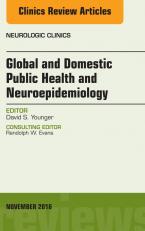Global and Domestic Public Health and Neuroepidemiology, Neurologic Clinics, 2016, Edited by David S. Younger
This book is a compendium of the most pressing public health issues of this decade. The faculty have been drawn from New York University and each of their chapters have relevance for researchers, clinicians, students, allied health providers, and policymakers in the U.S. and abroad.
Research Methods in Epidemiology. David S. Younger et al. Neurol Clin 2016; 34:815-835.
This chapter reviews the basic measures of disease frequency, effect and association, validity and error estimation, and the major types of experimental and non-experimental epidemiologic study designs essential in public health.
I-Cubed (Infection, Immunity, and Inflammation) and the Human Microbiome. David S. Younger. Neurol Clin 2016; 34:863-874.
The essence of post-infectious autoimmunity is being understood as a combination of factors relating in part to the impact of our immune system to invading and resident in disorders as diverse as diabetes, HLAB27 spondyloarthropathy, Lyme disease and childhood neuropsychiatric disorders.
Epidemiology of Lyme Neuroborreliosis. David S. Younger. Neuro Clin 2016; 34:875-886
Lyme disease is caused by the bacterium Borrelia burgdorferi and is transmitted to humans through the bite of infected blacklegged Ixodes ticks. According to the CDC, Lyme disease is the most commonly reported vector-borne illness making it an important public health concern. Undiagnosed and therefore untreated, infection disseminates to the nervous system.
Epidemiology of Neurovasculitis. David S. Younger. Neurol Clin 2016; 34:887-917
Vasculitis is defined as inflammation of arteries or veins of varying calibers. The nosology and definitions for the commonest forms of vasculitis are reviewed along with the approach to management of affected children and adults.
Epidemiology of Multiple Sclerosis. Jonathan Howard, Stephen Trevick and David S. Younger. Neurol Clin 2016; 34:919-939.
Multiple sclerosis or MS, are autoimmune and genetic demyelinating diseases of the brain and spinal cord that progress in time and space within the central nervous system. Management includes treatment with immunosuppressant and novel biologic agents and supportive care.
Epidemiology of Ischemic Stroke. Albert Favate and David S. Younger. Neurol Clin 2016; 34:967-980.
Ischemic stroke causes sudden onset of neurologic signs related to the sites of injury in the brain. The burden stroke is impacting domestic and global populations world-wide making it an important public health concern.
Epidemiology of Childhood and Adult Mental Illness. David S. Younger. Neurol Clin 2016; 34:1023-1033.
Mental illness accounts for a greater proportion of disability than cancer and heart disease in adults. Affected children can present with cognitive, social and emotional deviations. Unrecognized and therefore untreated there can be chronic indolent or devastating consequences.
Childhood Vaccination. David S. Younger et al. Neurol Clin 2016; 34:1035-1047.
Vaccination involves the induction of host protective immunity to prevent the spread of potentially fatal or emerging illnesses, in particular those immunologically naïve. Worldwide collaboration is a necessary aspect of vaccine-preventable diseases to prevent emergence of disease in geographically remote areas.
Epidemiology of Zika Virus. David S. Younger. Neurol Clin 2016; 34:1049-1056.
Zika virus is a Flaviviridae arbovirus transmitted by Aedes mosquitoes and through inter-human contact. There is neither a vaccine nor prophylactic medications available to prevent infection. The risk to the unborn fetus occurs throughout gestation with the most serious consequences in the first trimester.
Assessing the Public’s Health. David S. Younger. Neurol Clin 2016; 34:1057-1070.
Metrics are an important part of the assessment of public health to describe the disability engendered by diseases. Epidemiology has transformed the understanding of risk factors for disease; however, a holistic approach includes recognition of social determinants and the neighborhood and communities where the people most at risk reside.
